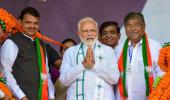By conventional yardsticks, Das was an audacious choice by Prime Minister Narendra Modi and the BJP president Amit Shah, like Devendra Fadnavis was in Maharashtra and Manohar Lal Khattar in Haryana. Will his choice pay off in the elections next month?
Radhika Ramaseshan reports.

Like a constellation of stars, circumstances conjugated to anoint Raghubar Das sixth chief minister of Jharkhand, on December 28, 2014.
Two of his predecessors from the Bharatiya Janata Party -- to which Das belongs -- were out of the reckoning: Babulal Marandi quit and floated his own outfit while Arjun Munda lost the election that year.
By conventional yardsticks, Das was an audacious choice by Prime Minister Narendra Modi and the BJP president Amit Shah, like Devendra Fadnavis was in Maharashtra and Manohar Lal Khattar in Haryana.
According to a Ranchi-based political observer, “The choice was part of the politics that the BJP pursued at that point, to bring the non-tribals under one umbrella.”
The tribals constitute a little over 25 per cent of Jharkhand’s population and the upper castes, Other Backward Classes, Dalits, and Muslims and Christians the rest.
In the non-tribal spectrum, the OBCs form the largest chunk.
Like Modi, Das is from the Teli caste. In Jharkhand, the Telis are traders by occupation but classified among the OBCs.
“The BJP wanted to break the established matrix of tribal dominance that came into being ever since Jharkhand was formed (in 2000),” noted the observer.
Senior leader and MLA Saryu Rai might have been considered but he is from an upper caste with little experience in administration.
Unlike Khattar, Das was a seasoned hand at exercising authority. He was urban development minister in the BJP-led government headed by Munda in 2005 and deputy chief minister in a coalition of the Jharkhand Mukti Morcha and BJP with Shibu Soren as chief minister.
While Rai won his first election only in 2005, Das has been an MLA from Jamshedpur East since 1995 -- an achievement for an “outsider” who hails from Chhattisgarh and not Jharkhand.
While Khattar and Fadnavis -- who, like Das, are part of the BJP’s new leadership line-up -- recommended themselves to the top jobs because they were believed to start off on a “clean slate”, without carrying an inconvenient baggage, Das courted controversy as a minister.
As deputy chief minister in June 2010, he was accused of colluding with a Singapore firm and allegedly granting “undue favours”. A high-powered committee constituted by the Jharkhand legislature indicted Das for awarding a contract worth Rs 200 crore to the Meinhardt Group to renew Ranchi’s sewerage infrastructure. The project was a no-go.
The stars were benevolent towards Das from the start. He was another BJP karyakarta (worker) and an employee of Tata Steel, Jamshedpur, in the labour department when K N Govindacharya, a former BJP general secretary, chose him to contest from Jamshedpur East over Dinanath Pandey, the sitting legislator. Those days, Govindacharya was prabhari (minder) of undivided Bihar. Das won, albeit by a narrow margin, which improved thereafter.
Agitational politics was his metier from the start and that’s what caught Govindacharya’s attention. In 1994-95, under the banner of the Basti Vikas Samiti, he led protests to claim ownership rights for 86 slums located outside the Tata Steel command areas and succeeded.
Das never let the success slip away from public consciousness. In 2018, he got a law passed to legalise the lease “bandobasti”, which guaranteed lease rights over government land to the occupants for 30 years, subject to renewal but without allowing for transfer.
Opinion was divided over Das’s tenure as the head of the Jharkhand government. There was an overall consensus over the political and administrative “stability” he brought to the fledgeling state.
“He’s the first chief minister to complete a five-year tenure,” said Shivpujan Pathak, the state BJP’s spokesperson, adding, “After the various aborted coalition experiments, our slogan (in 2014) was no development is possible without a majority sarkar. Of course, we had a coalition with a smaller party (the All Jharkhand Students Union) and later we took away all the six MLAs of the Marandi’s Jharkhand Vikas Morcha-Prajatantrik. With a BJP government at the Centre, a neglected state was fuelled by double-engine growth.”
For Pathak, Das’s “greatest” achievements were “eliminating” the Maoist insurgents through “encounter killings, surrender or cooption”, refurbishing Jharkhand’s image as “corruption-free” (however, he admitted while there were no “mega” scams, it was not possible to uproot petty corruption), and supplementing and augmenting the Centre’s welfare schemes such as Ujwala and PM-Kisan with parallel state projects).
The negatives? In adhering to the “Gujarat model of governance”, Das centralised power in the chief minister’s office which he allegedly packed with loyal apparatchiks from his caste.
With less than a month before he faces the people again, will Das be second-time lucky?











